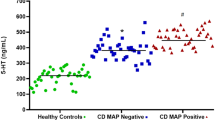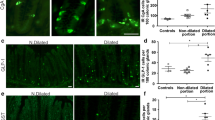Abstract
Background
Trypanosoma cruzi (T. cruzi) infects millions of Latin Americans each year and can induce chagasic megacolon. Little is known about how serotonin (5-HT) modulates this condition. Aim We investigated whether 5-HT synthesis alters T. cruzi infection in the colon.
Materials and Methods
Forty-eight paraffin-embedded samples from normal colon and chagasic megacolon were histopathologically analyzed (173/2009). Tryptophan hydroxylase 1 (Tph1) knockout (KO) mice and c-KitW-sh mice underwent T. cruzi infection together with their wild-type counterparts. Also, mice underwent different drug treatments (16.1.1064.60.3).
Results
In both humans and experimental mouse models, the serotonergic system was activated by T. cruzi infection (p < 0.05). While treating Tph1KO mice with 5-HT did not significantly increase parasitemia in the colon (p > 0.05), rescuing its synthesis promoted trypanosomiasis (p < 0.01). T. cruzi-related 5-HT release (p < 0.05) seemed not only to increase inflammatory signaling, but also to enlarge the pericryptal macrophage and mast cell populations (p < 0.01). Knocking out mast cells reduced trypanosomiasis (p < 0.01), although it did not further alter the neuroendocrine cell number and Tph1 expression (p > 0.05). Further experimentation revealed that pharmacologically inhibiting mast cell activity reduced colonic infection (p < 0.01). A similar finding was achieved when 5-HT synthesis was blocked in c-KitW-sh mice (p > 0.05). However, inhibiting mast cell activity in Tph1KO mice increased colonic trypanosomiasis (p < 0.01).
Conclusion
We show that mast cells may modulate the T. cruzi-related increase of 5-HT synthesis in the intestinal colon.








Similar content being viewed by others
References
Chagas C. Tripanosomiase americana; forma aguda da doença. Mem Inst Oswaldo Cruz. 1916;8:37–60.
Robertson LJ, Devleesschauwer B, Alarcon de Noya B, Noya Gonzalez O, Torgerson PR. Trypanosoma cruzi: time for international recognition as a foodborne parasite. PLoS Neglected Tropical Diseases. 2016;10:e0004656.
Rassi A Jr, Rassi A, Marin-Neto JA. Chagas disease. Lancet. 2010;375:1388–1402.
Koeberle F. Enteromegaly and cardiomegaly in chagas disease. Gut. 1963;4:399–405.
Freitas MA, Segatto N, Tischler N, de Oliveira EC, Brehmer A, da Silveira AB. Relation between mast cells concentration and serotonin expression in chagasic megacolon development. Parasite Immunol. 2017;39:e12414.
de Freitas MA, de Oliveira EC, de Oliveira FC, Jabari S, Brehmer A, da Silveira AB. Is the increased presence of CD8 T-lymphocytes related to serotonin levels in Chagas disease? Colorectal Dis. 2015;17:268–269.
Heredia DJ, Gershon MD, Koh SD, Corrigan RD, Okamoto T, Smith TK. Important role of mucosal serotonin in colonic propulsion and peristaltic reflexes: in vitro analyses in mice lacking tryptophan hydroxylase 1. J Physiol. 2013;591:5939–5957.
Stone TW, Darlington LG. Endogenous kynurenines as targets for drug discovery and development. Nat Rev Drug Discov. 2002;1:609–620.
Chin A, Svejda B, Gustafsson BI, et al. The role of mechanical forces and adenosine in the regulation of intestinal enterochromaffin cell serotonin secretion. Am J Physiol Gastrointest Liver Physiol. 2012;302:G397–G405.
Qiu HM, Yang JX, Jiang XH, et al. Upregulating serotonin transporter expression and downregulating monoamine oxidase-A and indoleamine 2, 3-dioxygenase expression involved in the antidepressant effect of sodium valproate in a rat model. Neuroreport. 2014;25:1338–1343.
Ghia JE, Li N, Wang H, et al. Serotonin has a key role in pathogenesis of experimental colitis. Gastroenterology. 2009;137:1649–1660.
Bischoff SC, Mailer R, Pabst O, et al. Role of serotonin in intestinal inflammation: knockout of serotonin reuptake transporter exacerbates 2,4,6-trinitrobenzene sulfonic acid colitis in mice. Am J Physiol Gastrointest Liver Physiol. 2009;296:G685–G695.
Martins PR, Nascimento RD, Lopes JG et al. Mast cells in the colon of Trypanosoma cruzi-infected patients: are they involved in the recruitment, survival and/or activation of eosinophils? Parasitol Res. 2015;114:1847–1856.
da Silveira AB, Adad SJ, Correa-Oliveira R, Furness JB, D’Avila Reis D. Morphometric study of eosinophils, mast cells, macrophages and fibrosis in the colon of chronic chagasic patients with and without megacolon. Parasitology. 2007;134:789–796.
Nagata K, Fujimiya M, Sugiura H, Uehara M. Intracellular localization of serotonin in mast cells of the colon in normal and colitis rats. Histochem J. 2001;33:559–568.
Adad SJ, Cancado CG, Etchebehere RM, et al. Neuron count reevaluation in the myenteric plexus of chagasic megacolon after morphometric neuron analysis. Virchows Arch. 2001;438:254–258.
Kannen V, Hintzsche H, Zanette DL, et al. Antiproliferative effects of fluoxetine on colon cancer cells and in a colonic carcinogen mouse model. PLoS One. 2012;7:e50043.
Walther DJ, Peter JU, Bashammakh S, et al. Synthesis of serotonin by a second tryptophan hydroxylase isoform. Science. 2003;299:76.
Lyon MF, Glenister PH. A new allele sash (Wsh) at the W-locus and a spontaneous recessive lethal in mice. Genet Res. 1982;39:315–322.
Arantes JM, Francisco AF, de Abreu Vieira PM, et al. Trypanosoma cruzi: desferrioxamine decreases mortality and parasitemia in infected mice through a trypanostatic effect. Exp Parasitol. 2011;128:401–408.
Carvalho TL, Ribeiro RD, Lopes RA. The male reproductive organs in experimental Chagas’ disease. I. Morphometric study of the vas deferens in the acute phase of the disease. Exp Pathol. 1991;41:203–214.
Tarleton RL, Grusby MJ, Zhang L. Increased susceptibility of Stat4-deficient and enhanced resistance in Stat6-deficient mice to infection with Trypanosoma cruzi. J Immunol. 2000;165:1520–1525.
Julio-Pieper M, O’Mahony CM, Clarke G, Bravo JA, Dinan TG, Cryan JF. Chronic stress-induced alterations in mouse colonic 5-HT and defecation responses are strain dependent. Stress. 2012;15:218–226.
van den Boogaard FE, Brands X, Roelofs JJ, et al. Mast cells impair host defense during murine Streptococcus pneumoniae pneumonia. J Infect Dis. 2014;210:1376–1384.
Chrusciel TL, Herman ZS. Effect of dopalanine on behaviour in mice depleted of norepinephrine or serotonin. Psychopharmacologia. 1969;14:124–134.
Cummings KL, Tarleton RL. Rapid quantitation of Trypanosoma cruzi in host tissue by real-time PCR. Mol Biochem Parasitol. 2003;129:53–59.
Brener Z. Therapeutic activity and criterion of cure on mice experimentally infected with Trypanosoma cruzi. Revista do Instituto de Medicina Tropical de Sao Paulo. 1962;4:389–396.
Cote F, Thevenot E, Fligny C, et al. Disruption of the nonneuronal tph1 gene demonstrates the importance of peripheral serotonin in cardiac function. Proc Natl Acad Sci USA. 2003;100:13525–13530.
Gutknecht L, Kriegebaum C, Waider J, Schmitt A, Lesch KP. Spatio-temporal expression of tryptophan hydroxylase isoforms in murine and human brain: convergent data from Tph2 knockout mice. Eur Neuropsychopharmacol. 2009;19:266–282.
Santos GC, Zucoloto S, Garcia SB. Endocrine cells in the denervated intestine. Int J Exp Pathol. 2000;81:265–270.
Hernandes L, Gama P, Alvares EP. Ileal VIP submucous neurons: confocal study of the area enlargement induced by myenteric denervation in weanling rats. Regul Pept. 2004;117:69–72.
Roth KA, Hertz JM, Gordon JI. Mapping enteroendocrine cell populations in transgenic mice reveals an unexpected degree of complexity in cellular differentiation within the gastrointestinal tract. J Cell Biol. 1990;110:1791–1801.
Zhu JX, Zhu XY, Owyang C, Li Y. Intestinal serotonin acts as a paracrine substance to mediate vagal signal transmission evoked by luminal factors in the rat. J Physiol. 2001;530:431–442.
Liu M, Geddis MS, Wen Y, Setlik W, Gershon MD. Expression and function of 5-HT4 receptors in the mouse enteric nervous system. Am J Physiol Gastrointest Liver Physiol. 2005;289:G1148–G1163.
Livingstone MS, Tempel BL. Genetic dissection of monoamine neurotransmitter synthesis in Drosophila. Nature. 1983;303:67–70.
Eiden LE, Schafer MK, Weihe E, Schutz B. The vesicular amine transporter family (SLC18): amine/proton antiporters required for vesicular accumulation and regulated exocytotic secretion of monoamines and acetylcholine. Pflugers Archiv. 2004;447:636–640.
Blakely RD, Ramamoorthy S, Schroeter S, et al. Regulated phosphorylation and trafficking of antidepressant-sensitive serotonin transporter proteins. Biol Psychiatry. 1998;44:169–178.
Hare ML. Tyramine oxidase: A new enzyme system in liver. Biochem J. 1928;22:968–979.
Spiller RC, Jenkins D, Thornley JP, et al. Increased rectal mucosal enteroendocrine cells, T lymphocytes, and increased gut permeability following acute Campylobacter enteritis and in post-dysenteric irritable bowel syndrome. Gut. 2000;47:804–811.
Wheatcroft J, Wakelin D, Smith A, Mahoney CR, Mawe G, Spiller R. Enterochromaffin cell hyperplasia and decreased serotonin transporter in a mouse model of postinfectious bowel dysfunction. Neurogastroenterol Motil. 2005;17:863–870.
Essien BE, Grasberger H, Romain RD, et al. ZBP-89 regulates expression of tryptophan hydroxylase I and mucosal defense against Salmonella typhimurium in mice. Gastroenterology. 2013;144:1466–1477.
Manocha M, Shajib MS, Rahman MM, et al. IL-13-mediated immunological control of enterochromaffin cell hyperplasia and serotonin production in the gut. Mucosal Immunol. 2013;6:146–155.
Wang H, Steeds J, Motomura Y, et al. CD4 + T cell-mediated immunological control of enterochromaffin cell hyperplasia and 5-hydroxytryptamine production in enteric infection. Gut. 2007;56:949–957.
Giroux M, Descoteaux A. Cyclooxygenase-2 expression in macrophages: modulation by protein kinase C-alpha. J Immunol. 2000;165:3985–3991.
de Las Casas-Engel M, Corbi AL. Serotonin modulation of macrophage polarization: inflammation and beyond. Adv Exp Med Biol. 2014;824:89–115.
Li N, Ghia JE, Wang H, et al. Serotonin activates dendritic cell function in the context of gut inflammation. Am J Pathol. 2011;178:662–671.
Linden DR, Foley KF, McQuoid C, Simpson J, Sharkey KA, Mawe GM. Serotonin transporter function and expression are reduced in mice with TNBS-induced colitis. Neurogastroenterol Motil. 2005;17:565–574.
Stoyanova II, Gulubova MV. Mast cells and inflammatory mediators in chronic ulcerative colitis. Acta Histochem. 2002;104:185–192.
Kushnir-Sukhov NM, Gilfillan AM, Coleman JW, et al. 5-hydroxytryptamine induces mast cell adhesion and migration. J Immunol. 2006;177:6422–6432.
Hundley TR, Prasad AR, Beaven MA. Elevated levels of cyclooxygenase-2 in antigen-stimulated mast cells is associated with minimal activation of p38 mitogen-activated protein kinase. J Immunol. 2001;167:1629–1636.
Harville BA, Dreyfus LA. Release of serotonin from RBL-2H3 cells by the Escherichia coli peptide toxin STb. Peptides. 1996;17:363–366.
Acknowledgments
The authors also disclose receipt of the following financial support for the development of this investigation: the National Council for Scientific and Technological Development (CNPQ; 443376/2014-0), Sao Paulo Research Foundation (FAPESP; 2014/06428-5), and Russian Science Foundation (No. 14-50-00069). The funders had no role in the study design, data collection, analysis, decision to publish, or preparation of the manuscript.
Author information
Authors and Affiliations
Contributions
Study concept and design: VK and SBG. Acquisition of data: BG, JYS, NA, MB, RRT, ECO, DCS, JSS, MVA, CRF, ZAC, SAU. Statistical analysis: VK and SBG. Analysis and interpretation of data: VK and SBG. Drafting of the manuscript: All. Critical revision of the manuscript: All. Obtained funding: VK. Technical and material support: SAU, NA, MB, ECO, ZAC, DCS, MVA, SBG. Study supervision: SBG.
Corresponding author
Ethics declarations
Conflict of interest
All authors have no conflicts of interest to disclose.
Rights and permissions
About this article
Cite this article
Kannen, V., Sakita, J.Y., Carneiro, Z.A. et al. Mast Cells and Serotonin Synthesis Modulate Chagas Disease in the Colon: Clinical and Experimental Evidence. Dig Dis Sci 63, 1473–1484 (2018). https://doi.org/10.1007/s10620-018-5015-6
Received:
Accepted:
Published:
Issue Date:
DOI: https://doi.org/10.1007/s10620-018-5015-6




